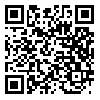Volume 13, Issue 1 (1-2024)
JCHR 2024, 13(1): 150-157 |
Back to browse issues page
Download citation:
BibTeX | RIS | EndNote | Medlars | ProCite | Reference Manager | RefWorks
Send citation to:



BibTeX | RIS | EndNote | Medlars | ProCite | Reference Manager | RefWorks
Send citation to:
Nakhaei E, Hosseini S, Mirzaei M, Vakili M, Hazar N. Evaluating Vaccination Delay in Infants during COVID-19 Outbreak in Yazd. JCHR 2024; 13 (1) :150-157
URL: http://jhr.ssu.ac.ir/article-1-1046-en.html
URL: http://jhr.ssu.ac.ir/article-1-1046-en.html
1- School of Medicine, Shahid Sadoughi University of Medical Sciences, Yazd, Iran
2- Center for Healthcare Data Modeling, Department of Biostatistics and Epidemiology, School of public health, Shahid Sadoughi University of Medical Sciences, Yazd, Iran- Department of Epidemiology, School of Public Health, Iran University of Medical Sciences, Tehran, Iran
3- Health Monitoring Research Center, School of Medicine, Shahid Sadoughi University of Medical Sciences, Yazd, Iran
4- Diabetes Research Center, Shahid Sadoughi University of Medical Sciences, Yazd, Iran ,narjeshazar@yahoo.com
2- Center for Healthcare Data Modeling, Department of Biostatistics and Epidemiology, School of public health, Shahid Sadoughi University of Medical Sciences, Yazd, Iran- Department of Epidemiology, School of Public Health, Iran University of Medical Sciences, Tehran, Iran
3- Health Monitoring Research Center, School of Medicine, Shahid Sadoughi University of Medical Sciences, Yazd, Iran
4- Diabetes Research Center, Shahid Sadoughi University of Medical Sciences, Yazd, Iran ,
Abstract: (341 Views)
Background: One of the potential consequences of COVID-19 is the interruption of childhood vaccination. The aim of this study is to investigate the frequency of vaccination delay in children during the COVID-19 outbreak in Yazd, Iran.
Methods: In this cross-sectional study in 2020, 667 children living in Yazd were enrolled through multi-stage sampling method. Date of birth, vaccination dates of 2-, 4-, and 6- months of age, gender, family size, birth order and municipal area were extracted from the Integrated System Information Block (SIB) system. Data were analyzed using SPSS software version 22.
Results: among 667 infants, 322 (48.3%) were girls and 345 (51.7%) were boys. In total, 53.5% of children had delay in vaccination at 2-month of age, 54%, at 4-month, and 45% at 6-month regarding vaccination appointment. Moreover, the dangerous delay was 3% in vaccination rounds for 2-month-olds, 5.4% for 4-month-olds, and 1.7% for 6-month-olds. At all the three appointments, there was a statistically significant difference between both the family size (P-value: 0.025, 0.017 and 0.004, respectively) and birth order (P-value: 0.015, 0.007 and 0.013, respectively) regarding vaccination delay.
Conclusion: Despite the high frequency of one or more than one day delay for 2-, 4-, and 6-month-old infants regarding vaccination appointments, dangerous delay in the mentioned times was relatively infrequent. Meanwhile, family size and birth order were two influential factors respecting vaccination delay in children. It is essential to raise awareness among families, particularly those with larger size and higher number of children about the importance of timely vaccination.
Methods: In this cross-sectional study in 2020, 667 children living in Yazd were enrolled through multi-stage sampling method. Date of birth, vaccination dates of 2-, 4-, and 6- months of age, gender, family size, birth order and municipal area were extracted from the Integrated System Information Block (SIB) system. Data were analyzed using SPSS software version 22.
Results: among 667 infants, 322 (48.3%) were girls and 345 (51.7%) were boys. In total, 53.5% of children had delay in vaccination at 2-month of age, 54%, at 4-month, and 45% at 6-month regarding vaccination appointment. Moreover, the dangerous delay was 3% in vaccination rounds for 2-month-olds, 5.4% for 4-month-olds, and 1.7% for 6-month-olds. At all the three appointments, there was a statistically significant difference between both the family size (P-value: 0.025, 0.017 and 0.004, respectively) and birth order (P-value: 0.015, 0.007 and 0.013, respectively) regarding vaccination delay.
Conclusion: Despite the high frequency of one or more than one day delay for 2-, 4-, and 6-month-old infants regarding vaccination appointments, dangerous delay in the mentioned times was relatively infrequent. Meanwhile, family size and birth order were two influential factors respecting vaccination delay in children. It is essential to raise awareness among families, particularly those with larger size and higher number of children about the importance of timely vaccination.
Send email to the article author
| Rights and permissions | |
 |
This work is licensed under a Creative Commons Attribution 4.0 International License. |







